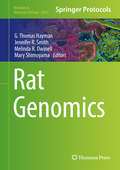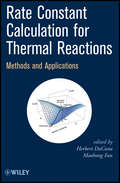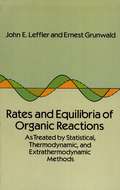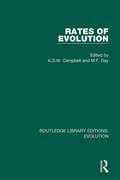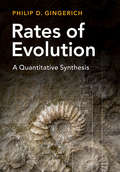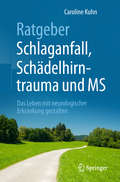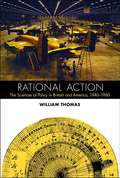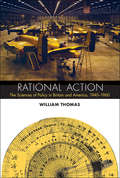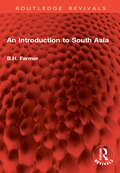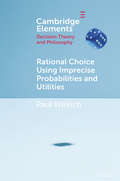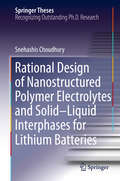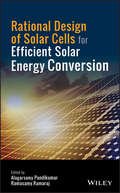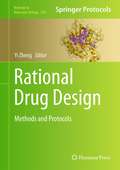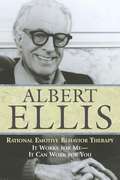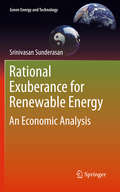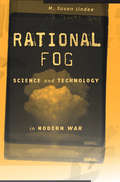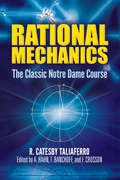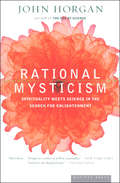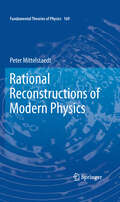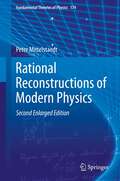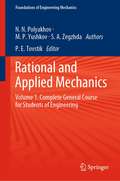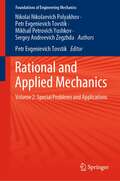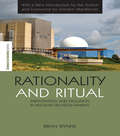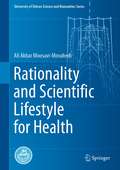- Table View
- List View
Rat Genomics (Methods in Molecular Biology #2018)
by G. Thomas Hayman Jennifer R. Smith Melinda R. Dwinell Mary ShimoyamaThis book provides both historical perspective and practical information to support researchers either currently involved in genomic research on rats or planning to begin such a project. In numerous chapters, a detailed protocol is provided for researchers looking to move into a new area of investigation or to leverage a new technology. In other cases, a detailed review of existing models or a description of available resources can help the researcher find, understand, and utilize the information, the data, and the tools that they need to support their research efforts. Written as part of the highly successful Methods in Molecular Biology series, this collection includes the kind of hands-on detail necessary for success in the lab. Authoritative and up-to-date, Rat Genomics explores the rat as a biomedical model uniquely poised to provide the ideal combination of established experimental models, extensive physiological data, and genomic manipulability to facilitate exploration of the underlying biology.
Rate Constant Calculation for Thermal Reactions
by Herbert Dacosta Maohong FanProviding an overview of the latest computational approaches to estimate rate constants for thermal reactions, this book addresses the theories behind various first-principle and approximation methods that have emerged in the last twenty years with validation examples. It presents in-depth applications of those theories to a wide range of basic and applied research areas. When doing modeling and simulation of chemical reactions (as in many other cases), one often has to compromise between higher-accuracy/higher-precision approaches (which are usually time-consuming) and approximate/lower-precision approaches (which often has the advantage of speed in providing results). This book covers both approaches. It is augmented by a wide-range of applications of the above methods to fuel combustion, unimolecular and bimolecular reactions, isomerization, polymerization, and to emission control of nitrogen oxides. An excellent resource for academics and industry members in physical chemistry, chemical engineering, and related fields.
Rates and Equilibria of Organic Reactions: As Treated by Statistical, Thermodynamic and Extrathermodynamic Methods
by Ernest Grunwald John E. LefflerGraduate-level text stresses extrathermodynamic approach to quantitative prediction and constructs a logical framework that encompasses and classifies all known extrathermodynamic relationships. Numerous figures and tables. Author and Subject Indexes.
Rates of Evolution (Routledge Library Editions: Evolution #2)
by K. S. W. Campbell M. F. DayOriginally published in 1987 Rates of Evolution is an edited collection drawn from a symposium convened to bring together palaeontologists, geneticists, molecular biologists and developmental biologists to examine some aspects of the problem of evolutionary rates. The book asks questions surrounding the study of evolution, such as did large morphological changes really occur rapidly at various times in the geological past, or is the fossil record too imperfect to be of value in assessing rates of morphological change? What is the measure of ‘rapid’ change? Is stasis at any taxonomic level established? Is it possible to relate genomic and morphological change? What is the role of regulatory and executive genes in controlling evolutionary change? Does the transfer of genetic material between different taxa provide the possibility of increasing evolutionary rates? Featuring contributions from leading researchers, this book will interest anthropologists, palaeontology and scientists of evolution and genetics.
Rates of Evolution: A Quantitative Synthesis
by Philip D. GingerichHow fast is evolution, and why does it matter? The rate of evolution, and whether it is gradual or punctuated, is a hotly debated topic among biologists and paleontologists. This book compiles and compares examples of evolution from laboratory, field, and fossil record studies, analyzing them to extract their underlying rates. It concludes that while change is slow when averaged over many generations, on a generation-to-generation time scale, evolution is rapid. Chapters cover the history of evolutionary studies, from Lamarck and Darwin in the nineteenth century to the present day. An overview of the statistics of variation, dynamics of random walks, processes of natural selection and random drift, and effects of scale and time averaging are also provided, along with methods for the analysis of evolutionary time series. Containing case studies and worked examples, this book is ideal for advanced students and researchers in paleontology, biology, and anthropology.
Ratgeber Schlaganfall, Schädelhirntrauma und MS: Das Leben mit neurologischer Erkrankung gestalten
by Peter Berlit Caroline KuhnDieses Buch bietet für medizinische Laien plausible Erklärungsmodelle für Hirnleistungsstörungen wie Schwindel, Gedächtnisprobleme, Müdigkeit oder Sehstörungen und fehlende Belastbarkeit. Damit der Alltag nach der Rehabilitationsphase gut gelingt, macht der Ratgeber verständlich, was im Gehirn passiert, wenn solche Probleme auftreten - zum Beispiel als Folgen von Schlaganfall oder einem Schädelhirntrauma, bei Multipler Sklerose oder einem Hirntumor. Das Buch bietet dem Betroffenen Lösungen und Strategien an, wie er damit gut umgehen und weiter am Leben teilnehmen kann. Mit vielen Übungen und Tipps für Betroffene und Angehörige, wie Probleme im Alltag entschärft und kritische Situationen gemeistert werden können.Ein Buch, das Mut macht, den Weg zurück in die aktive Gestaltung des Alltags und in den Beruf zu finden.
Rational Action
by William ThomasDuring World War II, the Allied military forces faced severe problems integrating equipment, tactics, and logistics into successful combat operations. To help confront these problems, scientists and engineers developed new means of studying which equipment designs would best meet the military's requirements and how the military could best use the equipment it had on hand. By 1941 they had also begun to gather and analyze data from combat operations to improve military leaders' ordinary planning activities. In Rational Action, William Thomas details these developments, and how they gave rise during the 1950s to a constellation of influential new fields -- which he terms the "sciences of policy" -- that included operations research, management science, systems analysis, and decision theory. Proponents of these new sciences embraced a variety of agendas. Some aimed to improve policymaking directly, while others theorized about how one decision could be considered more rational than another. Their work spanned systems engineering, applied mathematics, nuclear strategy, and the philosophy of science, and it found new niches in universities, in businesses, and at think tanks such as the RAND Corporation. The sciences of policy also took a prominent place in epic narratives told about the relationships among science, state, and society in an intellectual culture preoccupied with how technology and reason would shape the future. Thomas follows all these threads to illuminate and make new sense of the intricate relationships among scientific analysis, policymaking procedure, and institutional legitimacy at a crucial moment in British and American history.
Rational Action: The Sciences of Policy in Britain and America, 1940-1960 (Transformations: Studies in the History of Science and Technology)
by William ThomasThe evolution of a set of fields—including operations research and systems analysis—intended to improve policymaking and explore the nature of rational decision-making.During World War II, the Allied military forces faced severe problems integrating equipment, tactics, and logistics into successful combat operations. To help confront these problems, scientists and engineers developed new means of studying which equipment designs would best meet the military's requirements and how the military could best use the equipment it had on hand. By 1941 they had also begun to gather and analyze data from combat operations to improve military leaders' ordinary planning activities. In Rational Action, William Thomas details these developments, and how they gave rise during the 1950s to a constellation of influential new fields—which he terms the “sciences of policy”—that included operations research, management science, systems analysis, and decision theory.Proponents of these new sciences embraced a variety of agendas. Some aimed to improve policymaking directly, while others theorized about how one decision could be considered more rational than another. Their work spanned systems engineering, applied mathematics, nuclear strategy, and the philosophy of science, and it found new niches in universities, in businesses, and at think tanks such as the RAND Corporation. The sciences of policy also took a prominent place in epic narratives told about the relationships among science, state, and society in an intellectual culture preoccupied with how technology and reason would shape the future. Thomas follows all these threads to illuminate and make new sense of the intricate relationships among scientific analysis, policymaking procedure, and institutional legitimacy at a crucial moment in British and American history.
Rational Approaches to Structure, Activity, and Ecotoxicology of Agrochemicals
by Wilfried Draber Toshio FujitaThis book presents discussions of the most important aspects in the development of agrochemicals. The book covers such broad areas as structure activity and ecotoxicological analyses in comprehensive reviews for general methods and chronicles for individual examples. Topics in structure-activity relationships include how to combine submolecular structures of pharmacological interests and modify them according to chemorational models with computer-aided procedures such as the traditional Hansch-type QSAR, the sequential, simplex optimization, and molecular modeling. Topics in the ecotoxicology of organo phosphorus compounds are discussed in terms of the quantitative structure-toxicity relationship (QSTR). Chronicles of molecular orbital methodology in predicting environmental fates of agrochemicals are also provided. This volume will be invaluable for researchers in the agrochemical and pharmaceutical industries.
Rational Basis for Clinical Translation in Stroke Therapy (Frontiers in Neurotherapeutics Series)
by Giuseppe Micieli Diana AmanteaStroke remains one of the major causes of death and long-term disability worldwide. Currently, the only approved therapy for the acute treatment of this disease is thrombolysis, a strategy that can only be applied to a small percentage of patients due to its narrow therapeutic window. Unfortunately, during the last years numerous promising drugs th
Rational Choice Using Imprecise Probabilities and Utilities (Elements in Decision Theory and Philosophy)
by Paul WeirichAn agent often does not have precise probabilities or utilities to guide resolution of a decision problem. I advance a principle of rationality for making decisions in such cases. To begin, I represent the doxastic and conative state of an agent with a set of pairs of a probability assignment and a utility assignment. Then I support a decision principle that allows any act that maximizes expected utility according to some pair of assignments in the set. Assuming that computation of an option's expected utility uses comprehensive possible outcomes that include the option's risk, no consideration supports a stricter requirement.
Rational Design of Nanostructured Polymer Electrolytes and Solid–Liquid Interphases for Lithium Batteries (Springer Theses)
by Snehashis ChoudhuryThis thesis makes significant advances in the design of electrolytes and interfaces in electrochemical cells that utilize reactive metals as anodes. Such cells are of contemporary interest because they offer substantially higher charge storage capacity than state-of-the-art lithium-ion battery technology. Batteries based on metallic anodes are currently considered impractical and unsafe because recharge of the anode causes physical and chemical instabilities that produce dendritic deposition of the metal leading to catastrophic failure via thermal runaway. This thesis utilizes a combination of chemical synthesis, physical & electrochemical analysis, and materials theory to investigate structure, ion transport properties, and electrochemical behaviors of hybrid electrolytes and interfacial phases designed to prevent such instabilities. In particular, it demonstrates that relatively low-modulus electrolytes composed of cross-linked networks of polymer-grafted nanoparticles stabilize electrodeposition of reactive metals by multiple processes, including screening electrode electrolyte interactions at electrochemical interfaces and by regulating ion transport in tortuous nanopores. This discovery is significant because it overturns a longstanding perception in the field of nanoparticle-polymer hybrid electrolytes that only solid electrolytes with mechanical modulus higher than that of the metal electrode are able to stabilize electrodeposition of reactive metals.
Rational Design of Solar Cells for Efficient Solar Energy Conversion
by Alagarsamy Pandikumar Ramasamy RamarajAn interdisciplinary guide to the newest solar cell technology for efficient renewable energy Rational Design of Solar Cells for Efficient Solar Energy Conversion explores the development of the most recent solar technology and materials used to manufacture solar cells in order to achieve higher solar energy conversion efficiency. The text offers an interdisciplinary approach and combines information on dye-sensitized solar cells, organic solar cells, polymer solar cells, perovskite solar cells, and quantum dot solar cells. The text contains contributions from noted experts in the fields of chemistry, physics, materials science, and engineering. The authors review the development of components such as photoanodes, sensitizers, electrolytes, and photocathodes for high performance dye-sensitized solar cells. In addition, the text puts the focus on the design of material assemblies to achieve higher solar energy conversion. This important resource: Offers a comprehensive review of recent developments in solar cell technology Includes information on a variety of solar cell materials and devices, focusing on dye-sensitized solar cells Contains a thorough approach beginning with the fundamental material characterization and concluding with real-world device application. Presents content from researchers in multiple fields of study such as physicists, engineers, and material scientists Written for researchers, scientists, and engineers in university and industry laboratories, Rational Design of Solar Cells for Efficient Solar Energy Conversion offers a comprehensive review of the newest developments and applications of solar cells with contributions from a range of experts in various disciplines.
Rational Drug Design
by Yi ZhengOver the past three decades there have been new developments in therapeutic drug design. In Rational Drug Design: Methods and Protocols, expert researchers in the field detail many of the methodologies used to study rational drug design. These include methods such as virtual screening of chemical hits, rational lead discovery by high throughput screening, combinatorial and fragment based lead generation, peptide based drug discovery, and animal models of lead validation. Written in the highly successful Methods in Molecular BiologyTM series format, chapters include introductions to their respective topics, lists of the necessary materials and reagents, step-by-step, readily reproducible laboratory protocols, and key tips on troubleshooting and avoiding known pitfalls. Authoritative and practical, Rational Drug Design: Methods and Protocols seeks to aid scientists in the further study of rational drug design and future drug discovery.
Rational Emotive Behavior Therapy: It Works for Me - It Can Work for You
by Albert EllisEllis points out that when one is faced with a problem, we had better realize that we have a choice to think rationally or irrationally about the problem.
Rational Exuberance for Renewable Energy
by Srinivasan SunderasanRational Exuberance for Renewable Energy is a beyond-the-hype account of the underlying issues that encourage or plague widespread dissemination of renewable energy (RE) technologies. Renewable energy operates in the real world, and it cannot be assumed that the conventional theories and incentive structures of economics and business do not apply. The author argues that grants and subsidies could be provided to support research, development and technology improvement efforts, but should not be employed as an instrument of state policy to intervene in specific markets. It is important to recognize that although investors often demonstrate an appetite for market risk, they find technology risks and policy uncertainty much less appealing. Rational Exuberance for Renewable Energy blends classical economic theory with the everyday realities of the RE industry to identify incentive structures contributing to the success - or otherwise - of project implementation involving renewable sources and appropriate technologies. The book is a compilation of articles that analyze individual RE technologies, and offer multiple perspectives of the RE industry and markets. Rational Exuberance for Renewable Energy is intended for policy makers, advanced students of energy economics and sustainable development, and for potential mainstream investors.
Rational Fog: Science And Technology In Modern War
by M. Susan LindeeA thought-provoking examination of the intersections of knowledge and violence, and the quandaries and costs of modern, technoscientific warfare.Science and violence converge in modern warfare. While the finest minds of the twentieth century have improved human life, they have also produced human injury. They engineered radar, developed electronic computers, and helped mass produce penicillin all in the context of military mobilization. Scientists also developed chemical weapons, atomic bombs, and psychological warfare strategies.Rational Fog explores the quandary of scientific and technological productivity in an era of perpetual war. Science is, at its foundation, an international endeavor oriented toward advancing human welfare. At the same time, it has been nationalistic and militaristic in times of crisis and conflict. As our weapons have become more powerful, scientists have struggled to reconcile these tensions, engaging in heated debates over the problems inherent in exploiting science for military purposes. M. Susan Lindee examines this interplay between science and state violence and takes stock of researchers’ efforts to respond. Many scientists who wanted to distance their work from killing have found it difficult and have succumbed to the exigencies of war. Indeed, Lindee notes that scientists who otherwise oppose violence have sometimes been swept up in the spirit of militarism when war breaks out.From the first uses of the gun to the mass production of DDT and the twenty-first-century battlefield of the mind, the science of war has achieved remarkable things at great human cost. Rational Fog reminds us that, for scientists and for us all, moral costs sometimes mount alongside technological and scientific advances.
Rational Mechanics: The Classic Notre Dame Course
by R. Catesby Taliaferro F. Crosson A. Hahn T. BanchoffDeveloped from a classic undergraduate course on the study of the motion of bodies, this volume stresses the history of science as well as relevant physics and mathematics. R. Catesby Taliaferro developed a well-attended and much-revered course during his 20-year tenure at Notre Dame. He left among his papers the unfinished manuscript for this text, which has now been completed and prepared for publication by a group of his former students and colleagues.Suitable for undergraduates and beginning graduate students of physics and the history of science, this volume begins with an exploration of ancient Greek celestial mechanics and the seventeenth-century scientific revolution incited by Kepler's work. Subsequent chapters examine vector spaces and their applications, elementary differential geometry, particle dynamics, displacement and kinematics, theories of light, and the special theory of relativity.
Rational Mysticism: Spirituality Meets Science in the Search for Enlightenment
by John HorganIn Rational Mysticism, acclaimed journalist John Horgan embarks on an adventure of discovery, investigating the ways in which scientists, theologians, and philosophers are attempting to formulate an empirical explanation of spiritual enlightenment. Horgan visits and interviews a fascinating Who's Who of experts, including theologian Huston Smith; Andrew Newberg, explorer of the brain's "God module"; Ken Wilber, a transpersonal psychologist and Buddhist; psychedelic pharmacologist Alexander Shulgin; Oxford-educated psychologist and Zen practitioner Susan Blackmore; and postmodern shaman Terence McKenna. Horgan also explores the effects of reputed enlightenment-inducing techniques such as fasting, meditation, prayer, sensory deprivation, and drug trips. In his lively and thought-provoking inquiry, Horgan finds surprising connections among seemingly disparate disciplines, not the least of which is a shared awe of the nature of the universe.
Rational Reconstructions of Modern Physics
by Peter MittelstaedtNewton’s classical physics and its underlying ontology are loaded with several metaphysical hypotheses that cannot be justified by rational reasoning nor by experimental evidence. Furthermore, it is well known that some of these hypotheses are not contained in the great theories of modern physics, such as the theory of relativity and quantum mechanics. This book shows that, on the basis of Newton’s classical physics and by rational reconstruction, the theory of relativity as well as quantum mechanics can be obtained by partly eliminating or attenuating the metaphysical hypotheses. Moreover, it is shown that these reconstructions do not require additional hypotheses or new experimental results.
Rational Reconstructions of Modern Physics, 2nd Enlarged Edition
by Peter MittelstaedtNewton's classical physics and its underlying ontology are loaded with several metaphysical hypotheses that cannot be justified by rational reasoning nor by experimental evidence. Furthermore, it is well known that some of these hypotheses are not contained in the great theories of Modern Physics, such as the theory of Special Relativity and Quantum Mechanics. This book shows that, on the basis of Newton's classical physics and by rational reconstruction, the theory of Special Relativity as well as Quantum Mechanics can be obtained by partly eliminating or attenuating the metaphysical hypotheses. Moreover, it is shown that these reconstructions do not require additional hypotheses or new experimental results. <P><P> In the second edition the rational reconstructions are completed with respect to General Relativity and Cosmology. In addition, the statistics of quantum objects is elaborated in more detail with respect to the rational reconstruction of quantum mechanics. The new material completes the approach of the book as much as it is possible at the present state of knowledge. Presumably, the most important contribution that is added to the second edition refers to the problem of interpretation of the three great theories of Modern Physics. It is shown in detail that in the light of rational reconstructions even realistic interpretations of the three theories of Modern Physics are possible and can easily be achieved.
Rational and Applied Mechanics: Volume 1. Complete General Course for Students of Engineering (Foundations of Engineering Mechanics)
by Nikolai Nikolaevich Polyakhov Mikhail Petrovich Yushkov Sergey Andreevich ZegzhdaAvailable for the first time in English, this two-volume course on theoretical and applied mechanics has been honed over decades by leading scientists and teachers, and is a primary teaching resource for engineering and maths students at St. Petersburg University.The course addresses classical branches of theoretical mechanics (Vol. 1), along with a wide range of advanced topics, special problems and applications (Vol. 2). This first volume of the textbook contains the parts “Kinematics” and “Dynamics”. The part “Kinematics” presents in detail the theory of curvilinear coordinates which is actively used in the part “Dynamics”, in particular, in the theory of constrained motion and variational principles in mechanics. For describing the motion of a system of particles, the notion of a Hertz representative point is used, and the notion of a tangent space is applied to investigate the motion of arbitrary mechanical systems. In the final chapters Hamilton-Jacobi theory is applied for the integration of equations of motion, and the elements of special relativity theory are presented.This textbook is aimed at students in mathematics and mechanics and at post-graduates and researchers in analytical mechanics.
Rational and Applied Mechanics: Volume 2. Special Problems and Applications (Foundations of Engineering Mechanics)
by Nikolai Nikolaevich Polyakhov Mikhail Petrovich Yushkov Sergey Andreevich Zegzhda Petr Evgenievich TovstikAvailable for the first time in English, this two-volume course on theoretical and applied mechanics has been honed over decades by leading scientists and teachers, and is a primary teaching resource for engineering and maths students at St. Petersburg University.The course addresses classical branches of theoretical mechanics (Vol. 1), along with a wide range of advanced topics, special problems and applications (Vol. 2). Among the special applications addressed in this second volume are: stability of motion, nonlinear oscillations, dynamics and statics of the Stewart platform, mechanics under random forces, elements of control theory, relations between nonholonomic mechanics and the control theory, vibration and autobalancing of rotor systems, physical theory of impact, statics and dynamics of a thin rod.This textbook is aimed at students in mathematics and mechanics and at post-graduates and researchers in analytical mechanics.
Rationality and Ritual: Participation and Exclusion in Nuclear Decision-making (The Earthscan Science in Society Series #Vol. 3)
by Brian WynneIn Rationality and Ritual, internationally renowned expert Brian Wynne offers a profound analysis of science and technology policymaking. By focusing on an episode of major importance in Britain's nuclear history – the Windscale Inquiry, a public hearing about the future of fuel reprocessing – he offers a powerful critique of such judicial procedures and the underlying assumptions of the rationalist approach. This second edition makes available again this classic and still very relevant work. Debates about nuclear power have come to the fore once again. Yet we still do not have adequate ways to make decisions or frame policy deliberation on these big issues, involving true public debate, rather than ritualistic processes in which the rules and scope of the debate are presumed and imposed by those in authority. The perspectives in this book are as significant and original as they were when it was written. The new edition contains a substantial introduction by the author reflecting on changes (and lack of) in the intervening years and introducing new themes, relevant to today's world of big science and technology, that can be drawn out of the original text. A new foreword by Gordon MacKerron, an expert on energy and nuclear policy, sets this seminal work in the context of contemporary nuclear and related big technology debates.
Rationality and Scientific Lifestyle for Health (University of Tehran Science and Humanities Series)
by Ali Akbar Moosavi-MovahediThis book argues that, to be healthy, human beings should love nature and stay in balance with it as much as possible. In other words: do not unbalance nature so that your own balance is not disturbed. The best and healthiest way for human beings to live is to find balance in life and nature. In this regard, the book discusses useful, nutritious, functional foods, nutraceuticals and antioxidants, and how natural molecules, which are provided by nature, can be the best medicine for human beings. At a molecular level, stress is defined by the presence of unbalanced free radicals in the body. Most diseases – especially type 2 diabetes, which accounts for the majority of diabetics – can be traced back to this problem. Our scientific evidence indicates that type 2 diabetes isn’t just a disease resulting from sugar, but also from stress. The book seeks to promote a healthier lifestyle by considering the psychoemotional dimension of wellness. And finally, it contends that good sleep is at the root of health and happiness for humanity, and that unbalanced free radicals are expelled from the body during restful sleep.The authors hope that this book will be a helpful guide and source of peace for readers, especially given their need for inner calm during the COVID-19 pandemic, and that the suggestions provided will show them the way to a better life.
